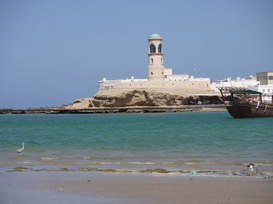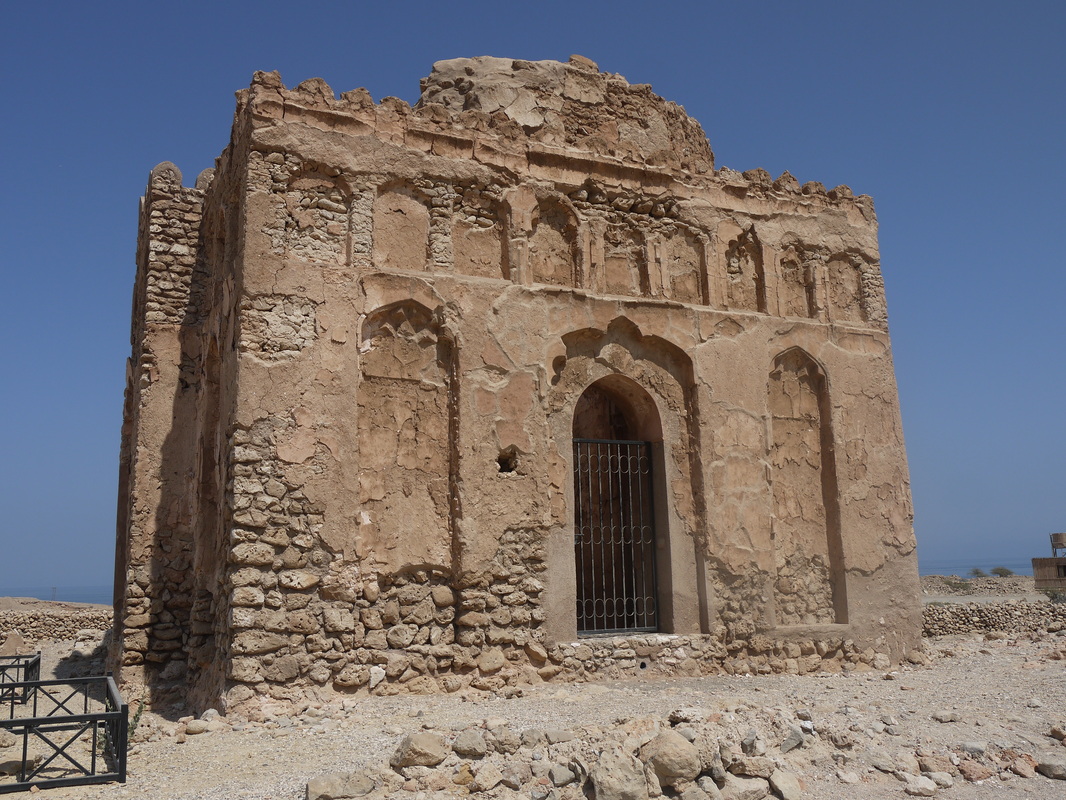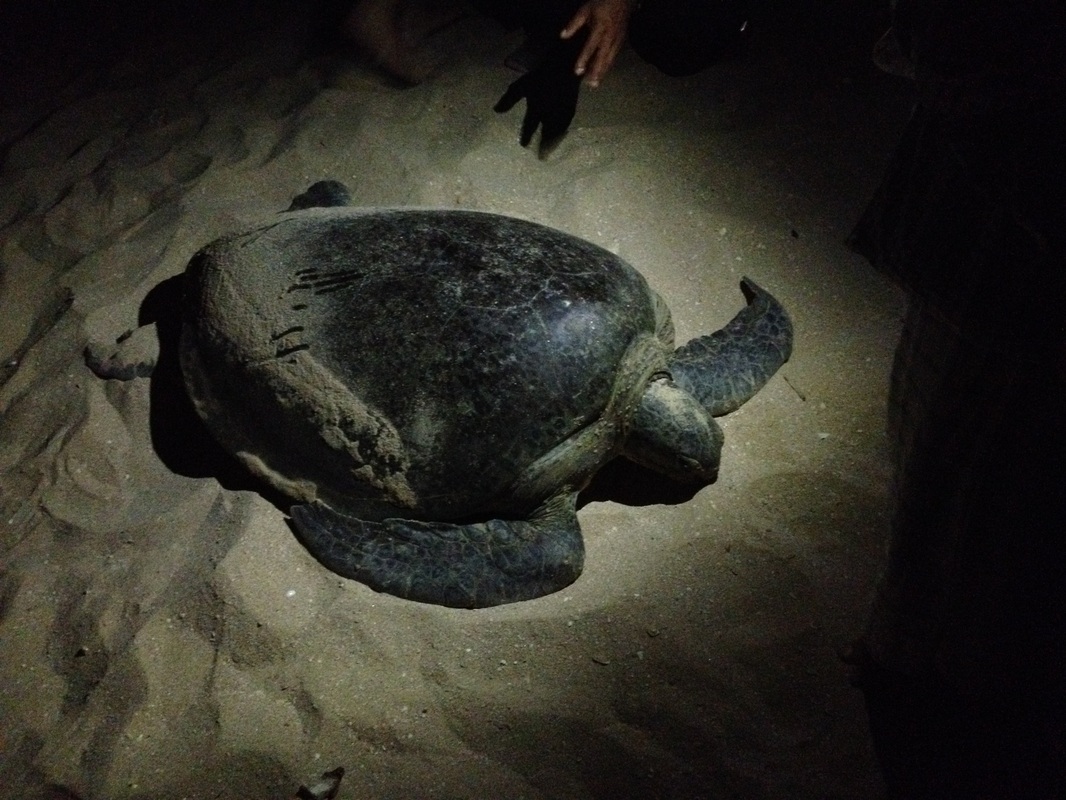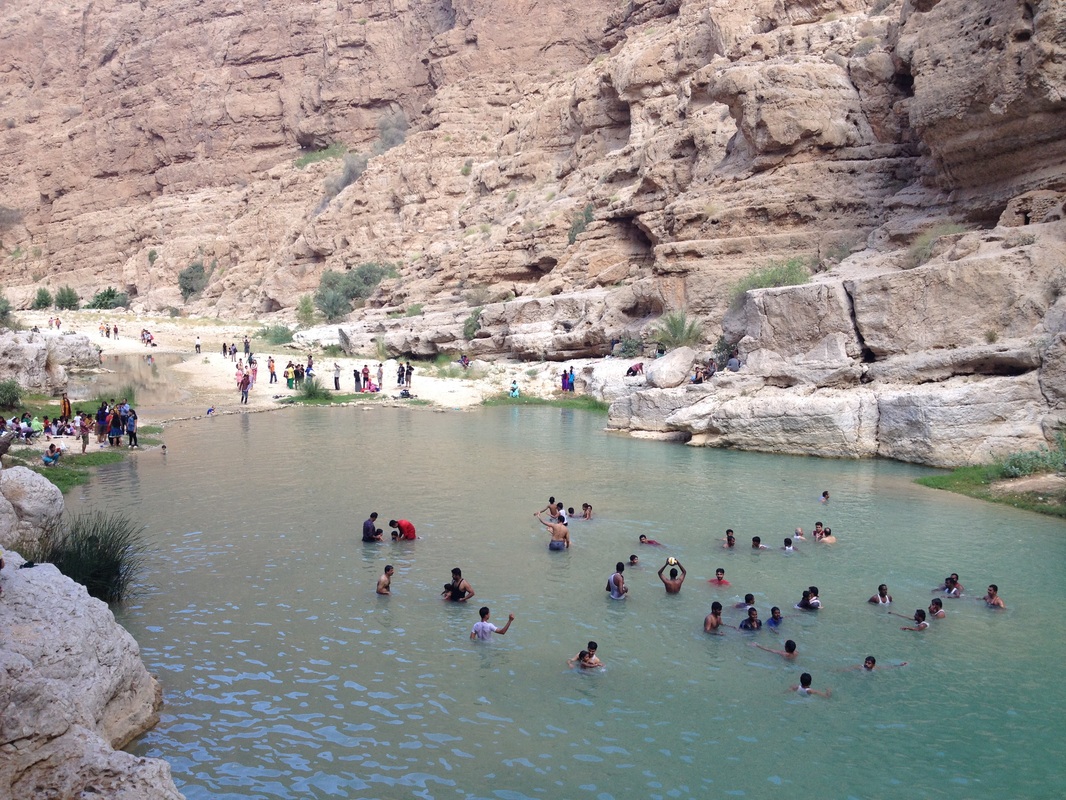
The fishing town of Sur is a pretty place to spend some time. With a long sweeping corniche, that provides picturesque views towards a natural cove it’s the perfect place to refuel.
Proud of its dhow building history some of the fishing vessels have been mounted on dry land so you have the opportunity to have a good look around. Hand-made from teak, often without any blue prints, the dhow is a status symbol and a reflection of a rich sea-faring heritage.
We walked up to the spit of land and flagged down a little boat, which ferried people back and forth the waterway. Until recently, when a road bridge was constructed, it was the only way to get across this expanse of water without going all the way round the lagoon. Mubarak, our ferryman, had lived in Sur all his life and gave us a little insight into the development of the town, which is a popular holiday destination for Omanis. He took us to the sand bars in the middle of the lagoon and then back up the water way to the opposite spit of land, where the village of Al Ayjah sits perched on the edge.
Given its remote position, it remains untouched, but the traffic now thunders over the bridge and a major road skims its edges. There is a lighthouse at the mouth of the lagoon, and pretty white low-rise buildings, broken periodically by mosque minarets. In the centre a fort proudly stands, guarded by two cannons, and surrounded by frisky goats that jump on and off parked cars. Remind me not to park where goats’ roam.
In stark contrast to the neat boxy houses we could see from afar, tucked in between were crumbing remnants of old buildings, now home to various livestock, who were not able to appreciate the faded grandeur or ornately carved doors. What I appreciated most was the lack of commercialism. This little hamlet, close enough to Sur to feel part of the modernised world, hadn’t been tempted to put up neon signs or open its doors for a quick dollar. From the trio of watch towers keeping out a beady eye, to the watchful and interested gaze of the residents, Al Ayjah felt like a town proud to have one foot in the past.
We walked back over the bridge, which gave us a super vantage point. While eating lunch, looking across the bay earlier, we had been treated to a show of silver flying fish teasing a rather frustrated looking heron. On top of the bridge we were able to see thousands of tiny fish swaying in its watery swarm, teasing bigger fish that darted and chased the piscatorial waves. The bigger fish leapt and dived with such force, but all they seemed able to do was divide the shoal, which very quickly morphed back together again. A lone heron stood on the bank, with what I hope was a look of bemusement on his face. He wasn’t the only one to fail at feasting on fast food.
Our accommodation for the night was the Turtle Beach Resorts, at Ras al Hadd. Hidden away down a dusty track and situated right on the beach, it is a quaint little place to stay, and the perfect location for trips to see the turtles. The rooms, made to look like barasti huts, are basic, but clean, some with en-suites and air conditioning. There is an evening buffet on the veranda of the dhow restaurant, overlooking a calm bay, and despite being family-friendly, surprisingly peaceful.
The resort arranged nightly trips to a nearby turtle beach in the evenings. We follow a snake of cars, led by a local guide. I had anticipated the excitement of seeing these gentle giants in the wild, but I don’t think I really appreciated how big they are. The one we met, and eventually followed into the sea, was about a metre long. It’s a rather breathtaking sight, especially when you compare it to its six centimetre babies. Madeleine, our eldest daughter was excited to be able to save a baby from being trampled on, and after much persuading that “Goldie”, the baby turtle, was better off with her mother than being kept as a pet, it was gently released into the sea.
Our final adventure was at Wadi ash Shab. Billed as one of the greatest walks in Oman, we were not disappointed. After crossing the wadi in a boat, the walk was easy going, passing several plantations and rock pools. The way gets steeper, and the rocks get bigger. At one point you walk along a ledge in the rock face, difficult but not impossible with children. The finale is, however, not suitable for young children or weak swimmers. At the last rock pool you have to swim 50m to a small gap in the rock face, which you either squeeze through or swim under, reappearing in a small cave with a waterfall flooded with light. It’s a fantastic reward.
The practical bit
What to do:
· Visit the Turtles. There is a conservation centre at Ras Al Jinz.
· Visit the hidden cave at Wadi ash Shab, near Tiwi, off route 17.
Where to stay:
Turtle Beach Resorts is at Ras al Hadd: www.tbroman.com
What to read:
· Oman Trekking by Explorer
· Oman Off-Road by Explorer
Keep you eye out for:
· The tiger rock: on the left side of the road towards Sur just after the Khawr Jirama lagoon.
· The 13th century tomb of Bibi Maryam, 20 minutes outside Sur at the ancient fishing village of Qalhat on route 17.
A bit of trivia:
· Sur was famous for its dhow building in the 19th and 20th centuries, with a heritage spanning 2,000 years. The handicrafts and skills needed to create a boat without drawings have been passed on from generation to generation. The boatyards are open if you want to see how the work is done and there is also a maritime museum so you can get close up to ships of all sizes.






 RSS Feed
RSS Feed
